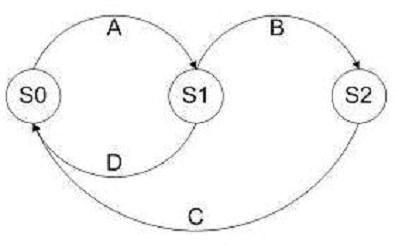Quick Skill Review Test for ISTQB Exam Q. 1 to 10
Objective Type / Multiple Choice Questions for preparation of ISTQB certification exam
(Quickly Review Your Skills before appearing for ISTQB Certification Exam)
Set of 10 Questions
Q. 1: Given the following state transition table Which of the test cases below will cover the following series of state transitions? S1 SO S1 S2 SO
Exhibit:

A. D, A, B, C.
B. A, B, C, D.
C. D, A, B.
D. A, B, C.
<<<<<< =================== >>>>>>
Q. 2: From a Testing perspective, what are the MAIN purposes of Configuration Management?:
i) Identifying the version of software under test.
ii) Controlling the version of testware items.
iii) Developing new testware items.
iv) Tracking changes to testware items.
v) Analysing the need for new testware items.
A. ii, iv and v.
B. ii, iii and iv.i,
C. i, ii and iv.
D. i, iii and v.
<<<<<< =================== >>>>>>
Q. 3: Which of the following is a MAJOR task of test planning?
A. Scheduling test analysis and design tasks.
B. Initiating corrective actions.
C. Monitoring progress and test coverage.
D. Measuring and analyzing results.
<<<<<< =================== >>>>>>
Q. 4: Which of the following BEST describes the difference between an inspection and a walkthrough?
A. Both inspections and walkthroughs are led by the author.
B. An inspection is led by a moderator and a walkthrough is led by the author.
C. Both inspections and walkthroughs are led by a trained moderator.
D. A walkthrough is led by the author. The author is not present during inspections.
<<<<<< =================== >>>>>>
Q. 5: Where may functional testing be performed?
A. At system and acceptance testing levels only.
B. At all test levels.
C. At all levels above integration testing.
D. At the acceptance testing level only.
<<<<<< =================== >>>>>>
Q. 6: What is the MAIN objective when reviewing a software deliverable?
A. To identify potential application failures by use of a test specification.
B. To identify defects in any software work product.
C. To identify spelling mistakes in a requirements specification.
D. To identify standards inconsistencies in the code.
<<<<<< =================== >>>>>>
Q. 7: Who would USUALLY perform debugging activities?
A. Developers.
B. Analysts.
C. Testers.
D. Incident Managers.
<<<<<< =================== >>>>>>
Q. 8: Which of the following would you NOT usually find on a software incident report?
A. The name and/or organisational position of the person raising the problem.
B. Version of the Software Under Test.
C. Suggestions as to how to fix the problem.
D. Actual and expected results.
<<<<<< =================== >>>>>>
Q. 9: Which of the following defines the expected results of a test?
A. Test case specification.
B. Test design specification.
C. Test procedure specification.
D. Test results.
<<<<<< =================== >>>>>>
Q. 10: Some tools are geared more for developer use. For the 5 tools listed, which statement BEST details those for developers
i) Performance testing tools.
ii) Coverage measurement tools.
iii) Test comparators.
iv) Dynamic analysis tools.
v) Incident management tools.
A. i, iii. and iv. are more for developers.
B. ii. and iv. are more for developers.
C. ii, iii. and iv. are more for developers.
D. ii. and iii. are more for developers.
Correct Answer of the above Questions
Many More Articles & Study Material on ISTQB Certification

An expert on R&D, Online Training and Publishing. He is M.Tech. (Honours) and is a part of the STG team since inception.
